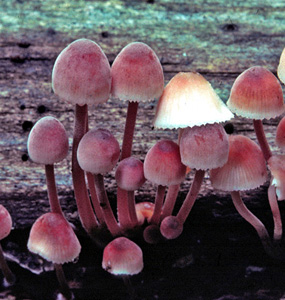Mycena haematopus

Image Courtesy of Peter Katsaros
| Click to Enlarge |
| Click For Image Gallery |
|
Group of Fungi: Agarics Family: Mycenaceae Latin Name: Mycena haematopus (Pers.) P. Kumm. Common Name: Bleeding Mycena Description: Total height 1 1/4–3 1/4 in (3–8 cm); cap 3/8–1 1/4 in (1-3 cm) wide, cone-shaped at first but becoming bell-shaped and then convex in age, dark reddish-brown towards the center and reddish-gray toward the margin, surface minutely hairy in young specimens but becoming smooth; margin prominently striate; gills only moderately close, dull pinkish-buff, bruising reddish-brown; stalk 1–3 in (2.5–7.5) long and 1/16–1/8 (0.15–0.3 cm) in diameter, minutely hairy above and with long, coarse hairs at the base, exuding a dark blood-red latex when cut; spores white in mass. Biological Role: Decomposer of wood. Habitat: On decaying wood of hardwoods and conifers; usually occurring in small groups. Geographical Distribution: Found throughout North America. Comments: Mycena haematopus is easily identified because of the dark-red (blood-like, hence the common name) latex that is readily apparent when the stalk of a fresh specimen of this fungus is broken. Mycena sanguinolenta is similar in appearance but smaller and occurs on the ground or associated with terrestrial mosses. |
| Go Back |